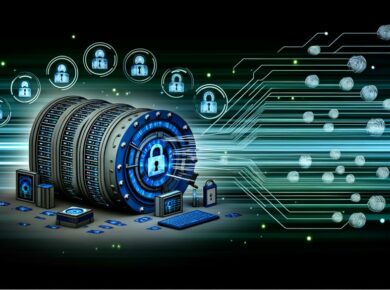Table of Contents Show
You must prioritize essential network security measures to protect your organization from cyber attacks. Start with a firewall to control traffic and block unauthorized access. Implement network segmentation to divide and secure different parts of your network. Access control systems restrict user access based on permissions. Use VPN solutions for secure remote connections. Email security protocols like spam filters and encryption thwart phishing. Data loss prevention tools monitor and block unauthorized data access. Intrusion prevention systems detect and stop threats in real-time. Train employees regularly to recognize threats. Conduct regular security audits to identify and fix vulnerabilities. Discover advanced techniques and tools for safeguarding your network.
Key Takeaways
- Firewalls control and inspect network traffic to block unauthorized access.
- Network segmentation divides the network to control access and limit threats.
- VPN solutions encrypt data for secure remote access.
- Access control systems restrict user permissions to protect sensitive data.
- Intrusion Prevention Systems monitor and block potential security threats in real-time.
Use a Firewall
To protect your network, you should use a firewall to control traffic and block unauthorized access. Firewalls are essential network security tools that act as a barrier between your internal network and external threats. They inspect incoming and outgoing traffic based on predetermined security rules, preventing unauthorized access and potential cyber threats.
For enhanced protection, consider Next Generation Firewalls (NGFW). Unlike traditional firewalls, NGFWs focus on blocking advanced malware and application-layer attacks. These sophisticated threats target specific applications, making NGFWs essential for robust network defense. NGFWs also include features like deep packet inspection, which allows them to examine data packets more thoroughly and discard any that are malicious or unauthorized.
Packet filtering is an important firewall function. By inspecting the headers and content of data packets, firewalls can identify and block harmful traffic before it reaches your network. This is particularly important for business network security, where protecting sensitive data is crucial.
Even basic operating systems like Windows and macOS come equipped with built-in firewalls. These built-in tools make it easier for you to implement fundamental network security measures.
Don't overlook the importance of a firewall in your network security strategy. It's a critical first line of defense against cyber threats.
Implement Network Segmentation
Implementing network segmentation divides your network into smaller, manageable segments to control access and limit the impact of potential breaches. By segmenting your network, you can strengthen your security posture and prevent unauthorized access effectively. Each segment is fortified with its own security controls and policies, making it harder for cyber threats to penetrate and cause damage.
Network segmentation enhances network resilience by isolating different parts of your network. This isolation helps contain breaches and limits the lateral movement of threats within your system. By reducing the attack surface, segmentation makes it more difficult for attackers to compromise multiple segments, thereby improving your overall security.
Here are three key benefits of network segmentation:
- Enhanced Security Controls: Each segment can have tailored security policies, making it harder for unauthorized access and breaches to occur.
- Reduced Attack Surface: By breaking down the network into smaller parts, you make it more challenging for cyber threats to spread.
- Improved Network Resilience: Isolating different segments helps contain breaches, minimizing damage and ensuring quicker recovery.
Access Control Systems

Moving from network segmentation, let's focus on access control systems that restrict user access based on specific permissions and policies to further secure your network.
Access control is essential for preventing unauthorized access and protecting sensitive data. When you implement network access control mechanisms like passwords, biometric scans, smart cards, and two-factor authentication, you create barriers that only allow authorized users into your network.
Network administrators play a key role in managing these access controls. They set up permissions and policies, making sure that only the right people can reach sensitive information. This helps in the prevention of data breaches and keeps your network secure.
Regularly updating these access control policies is crucial. If you don't keep them current, you risk leaving your network exposed to threats.
Monitoring user access activities is another critical step. By doing so, you can quickly spot suspicious behavior and react before any damage occurs. Remember, unauthorized access can lead to significant security issues.
Deploy VPN Solutions
In today's digital age, deploying VPN solutions is essential for safeguarding data transmission and ensuring secure remote access. VPN solutions create secure internet tunnels between devices, protecting data from prying eyes. They offer remote access capabilities while preventing unauthorized access to sensitive information. By encrypting data packets, VPNs guarantee data confidentiality and integrity during transmission.
Consider these key benefits of using VPN solutions:
- Secure Internet Tunnels: VPNs establish encrypted tunnels, making it nearly impossible for hackers to intercept or tamper with your data. This is critical for protecting sensitive information, especially when accessing public Wi-Fi networks.
- Remote Access: VPNs allow employees to securely connect to the company's network from anywhere. This remote access is essential in today's flexible work environment, ensuring productivity without compromising security.
- Real-time Threat Detection: Combining VPNs with intrusion prevention systems enhances your network's security. These systems provide real-time threat detection, identifying and blocking potential intrusions before they can cause damage.
Deploying VPN solutions is a proactive step in securing remote connections and preventing unauthorized access. Don't wait for a security breach to take action. Start implementing VPN solutions now to protect your data and maintain a secure network environment.
Email Security Protocols

To protect your organization from phishing attacks and malware, robust email security protocols are essential. Cyber threats targeting email systems are on the rise, making it imperative to implement effective measures.
Start by using spam filters to block unwanted emails and potential threats. This first line of defense can reduce the risk of data breaches and malicious software infiltrating your network.
Email authentication methods, such as SPF, DKIM, and DMARC, help verify the sender's identity and prevent unauthorized access to sensitive information. These protocols guarantee that only legitimate emails reach your inbox.
Additionally, encryption technologies like TLS/SSL are crucial for secure communication. They safeguard email content from being intercepted during transmission, maintaining the confidentiality and integrity of your data.
Regular security awareness training for employees is also essential. Educate them on recognizing phishing attempts and other email-based threats. This training reinforces best practices and empowers your team to act as the first line of defense against cyber attacks.
Data Loss Prevention
You need robust Data Loss Prevention (DLP) technology to monitor, detect, and block unauthorized access to sensitive data. Without it, your organization is at risk of data breaches, which can lead to severe financial and reputational damage.
DLP software helps you comply with regulatory requirements by safeguarding sensitive data. It works by classifying and tagging sensitive information, applying encryption, and enforcing strict access controls. This guarantees that only authorized personnel can access critical data, protecting your intellectual property and enhancing your overall data security posture.
Here's what effective DLP measures should include:
- Real-time Monitoring: DLP systems provide real-time alerts when unauthorized data transfer attempts are detected. This immediate response helps mitigate potential data breaches quickly.
- Data Classification and Tagging: By categorizing sensitive data, DLP tools make it easier to apply appropriate security measures, such as encryption and access controls, to prevent data leakage.
- Access Controls: Implementing stringent access controls ensures that only authorized users can access sensitive data, reducing the risk of data exposure.
Implementing DLP measures is essential to reduce the risk of data leaks and protect your organization's intellectual property. By taking these steps, you'll greatly improve your data security posture and safeguard your sensitive information.
Intrusion Prevention Systems

Intrusion Prevention Systems (IPS) actively monitor and protect your network by identifying and blocking potential security threats in real-time. They scrutinize network traffic to detect and halt malicious activities like unauthorized access, malware, and denial-of-service attacks. With IPS, you get real-time monitoring that keeps you a step ahead of cyber threats.
IPS employs predefined rules, signatures, and anomaly detection to analyze traffic behavior. These methods allow the system to spot and respond to suspicious activities swiftly.
Whether you choose network-based (NIPS) or host-based (HIPS), IPS offers strong protection at various levels of your network infrastructure. This layered defense is essential for sensitive data protection, ensuring that your important information stays secure.
Conduct Security Training
While Intrusion Prevention Systems offer robust defense mechanisms, educating your employees through regular security training is equally essential to bolster your organization's security posture.
Cyber threats are evolving rapidly, and without proper training, your workforce mightn't recognize these dangers until it's too late. Security training empowers your employees to identify and respond to various cyber threats, such as phishing attempts, malware, and social engineering tactics. By fostering security awareness, you can greatly reduce the risk of data breaches and cyber attacks often caused by human error.
Investing in security training is a proactive measure that yields substantial benefits. Here are three key areas it impacts:
- Recognition of Phishing Attempts: Employees learn to spot suspicious emails and avoid clicking on malicious links.
- Malware Prevention: Training helps employees understand how malware spreads and how to avoid downloading harmful software.
- Social Engineering Defense: Employees become adept at identifying and thwarting social engineering schemes designed to steal sensitive information.
Regular security training sessions ensure that your employees stay informed about the latest cyber threats and reinforce good security practices. By doing so, you strengthen your overall security posture and better protect your organization from potential data breaches and cyber threats.
Don't delay—make security training a priority today.
Regular Security Audits

Regular security audits are vital for identifying and addressing vulnerabilities in your network defenses. By conducting these audits regularly, you can pinpoint weaknesses before they become serious issues. It's important to verify that your security measures are up to date and functioning effectively to protect against potential threats.
When you perform regular security audits, you're not just looking for holes in your defenses; you're also evaluating compliance with security policies and regulations. This helps you stay in line with industry standards, avoiding any penalties or legal troubles. Audits give you insights into potential risks and threats, allowing you to take proactive steps to mitigate them.
A strong and resilient network security posture doesn't happen by accident. It requires constant vigilance and regular security audits to maintain. These audits help you stay ahead of cybercriminals by continuously improving your defenses. They highlight what's working and what needs improvement, ensuring your network is always prepared for any attack.
Conclusion
If you think your network is safe, think again. Without these essential measures:
- firewalls
- segmentation
- access control
- VPNs
- email security
- data loss prevention
- intrusion systems
you're leaving the door wide open.
Security training and regular audits aren't just optional; they're critical. Don't wait for a breach to wake up. Act now, secure your network, and protect your data.
Your future depends on it. Are you prepared to take that risk?




